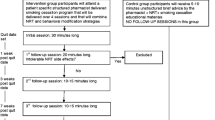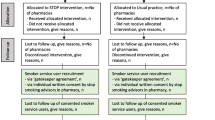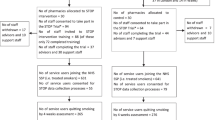Abstract
Background With the rising interest in expanding pharmacists’ role in smoking cessation, it is pertinent that community pharmacists be equipped with up-to-date knowledge and competence to provide optimal therapeutic services that meet the demands of various presenting subsets of smokers. Objective To investigate and evaluate responses to requests of quitting smoking from ‘high risk’ smokers seeking assistance and treatment within the pharmacy venue. Setting Community pharmacies located within Sydney greater metropolitan area, New South Wales, Australia. Method A simulated patient methodology was utilised. Two scenarios were developed and enacted by two trained simulated patients in 100 randomly selected pharmacies. Scenario 1 involved a 28-year-old pregnant female who presents with a request for help in quitting smoking. Scenario 2 involved a 22-year-old female requesting a quit smoking product for her 55-year-old father who has cardiovascular problems. A standardised scoring key was designed to assess the performance of pharmacists during each encounter. Main outcome measure The primary outcome measure was the supply/non-supply of nicotine replacement products and the corresponding provision of counselling and advice to facilitate smoking cessation. Results A product(s) was supplied in 42 % of the 100 encounters, while a product was adequately suggested pending doctor’s referral in 45 %. In 13 % of the cases, a product was not supplied based on inappropriate notions of nicotine replacement therapy not being safe in the presented scenario. Pharmacists performed better in dispensing scores (counselling about product use) as compared to pre-dispensing scores (eliciting patient history). ANOVA followed by regression analysis indicated that the estimated age and gender of the pharmacist/staff were significant predictors affecting total scores. Conclusion Whilst pharmacists’ counselling about smoking cessation aids seems satisfactory, further education is required to improve practice standards in terms of matching a patient’s history and smoking status to an appropriate product.


Similar content being viewed by others
References
Centers for Disease Control and Prevention. Smoking and tobacco use: fast facts. 2013 [cited 30 Oct 2013]. http://www.cdc.gov/tobacco/data_statistics/fact_sheets/fast_facts/.
World Health Organization. WHO framework convention on tobacco control. 2003 [cited 31 Oct 2013]. http://whqlibdoc.who.int/publications/2003/9241591013.pdf.
Cancer Council Victoria. Smokefree generation within reach after high court upholds plain packaging. Media Release. 2012 [cited 31 Oct 2013]. http://www.cancervic.org.au/about/media-releases/2012-media-releases/august-2012-media/smokefree-in-reach.html.
Rigotti NA, Clair C, Munafò MR, Stead LF. Interventions for smoking cessation in hospitalised patients. Cochrane Database Syst Rev. 2012;5:CD001837.
World Health Organization. WHO report on the global tobacco epidemic-enforcing bans on tobacco advertising, promotion and sponsorship. 2013 [cited 25 July 2013]. http://apps.who.int/iris/bitstream/10665/85380/1/9789241505871_eng.pdf.
American Cancer Society. CDC: adult smoking rates remain steady. 2012 [cited 25 July 2013]. http://www.cancer.org/cancer/news/cdc-adult-smoking-rates-remain-steady.
Chapman S, MacKenzie R. There’s nothing that succeeds like failure: discerning the woods from the trees in smoking cessation debates. Nicotine Tob Res. 2013;15(3):750–1.
ICD10 Data. Nicotine dependence F17. ICD-10-CM Coding reference. 2013 [cited 9 Nov 2013]. http://www.icd10data.com.
Stead LF, Perera R, Bullen C, Mant D, Hartmann-Boyce J, Cahill K, et al. Nicotine replacement therapy for smoking cessation. Cochrane Database Syst Rev. 2012;11:CD000146.
Thomas D. Smoking and cardiovascular diseases. Rev Prat. 2012;62(3):339–43.
Osadchy A, Kazmin A, Koren G. Nicotine replacement therapy during pregnancy: recommended or not recommended? J Obstet Gynaecol Can. 2009;31(8):744–7.
Coleman T, Chamberlain C, Davey MA, Cooper SE, Leonardi-Bee J. Pharmacological interventions for promoting smoking cessation during pregnancy. Cochrane Database Syst Rev. 2012;9:CD010078.
Brose LS, McEwen A, West R. Association between nicotine replacement therapy use in pregnancy and smoking cessation. Drug Alcohol Depend. 2013;132(3):660–4.
Dent LA, Harris KJ, Noonan CW. Tobacco interventions delivered by pharmacists: a summary and systematic review. Pharmacotherapy. 2007;27(7):1040–51.
Sinclair HK, Bond CM, Stead LF. Community pharmacy personnel interventions for smoking cessation. Cochrane Database Syst Rev. 2004;1:CD003698.
Blenkinsopp A, Anderson C, Armstrong M. Systematic review of the effectiveness of community pharmacy-based interventions to reduce risk behaviours and risk factors for coronary heart disease. J Public Health Med. 2003;25(2):144–53.
Roughead L, Semple S, Vitry A. The value of pharmacist professional services in the community setting: a systematic review of the literature 1990–2002. Adelaide, South Australia: Quality Use of Medicines and Pharmacy Research Centre, University of South Australia; 2003 [cited 31 Oct 2013]. http://beta.guild.org.au/uploadedfiles/Research_and_Development_Grants_Program/Projects/2002-507_fr.pdf.
Australian Bureau of Statistics. Tobacco smoking. 2012 [cited 1 Nov 2013]. http://www.abs.gov.au/ausstats/abs@.nsf/0/73963BA1EA6D6221CA257AA30014BE3E?opendocument.
Germain D, Durkin S, Scollo M, Wakefield M. The long-term decline of adult tobacco use in Victoria: changes in smoking initiation and quitting over a quarter of a century of tobacco control. Aust N Z J Public Health. 2012;36(1):17–23.
Ferguson SG, Shiffman S, Gitchell JG. Nicotine replacement therapies: patient safety and persistence. Patient Relat Outcome Meas. 2011;2:111–7.
Paul CL, Walsh RA, Girgis A. Nicotine replacement therapy products over the counter: real-life use in the Australian community. Aust N Z J Public Health. 2003;27(5):491–5.
Chiang P, Chapman S. Do pharmacy staff recommend evidenced-based smoking cessation products? A pseudo patron study. J Clin Pharm Ther. 2006;31(3):205–9.
Saba M, Bittoun R, Kritikos V, Saini B. Smoking cessation in community pharmacy practice-a clinical information needs analysis. SpringerPlus. 2013;2:449.
Zwar N, Richmond R, Borland R et al. Supporting smoking cessation: a guide for health professionals. Melbourne: The Royal Australian College of General Practitioners; 2011 [cited 1 Nov 2013]. http://www.racgp.org.au/download/documents/Guidelines/smoking-cessation.pdf.
Australian Government. National Tobacco Campaign 2013—more targeted approach campaign. 2013 [cited 2 Nov 2013]. http://quitnow.gov.au/internet/quitnow/publishing.nsf/Content/mta-2012-13.
ABC News. Heart attack victims continue to smoke despite warnings. 2013 [cited 2 Nov 2013]. http://www.abc.net.au/news/2013-07-29/heart-attack-victims-continue-to-smoke-despite/4849550.
Xu T, de Almeida Neto AC, Moles RJ. A systematic review of simulated-patient methods used in community pharmacy to assess the provision of non-prescription medicines. Int J Pharm Pract. 2012;20(5):307–19.
Chong WW, Aslani P, Chen TF. Pharmacist-patient communication on use of antidepressants: a simulated patient study in community pharmacy. Res Social Adm Pharm. 2014;10(2):419–37.
Kippist C, Wong K, Bartlett D, Saini B. How do pharmacists respond to complaints of acute insomnia? A simulated patient study. Int J Clin Pharm. 2011;33(2):237–45.
Queddeng K, Chaar B, Williams K. Emergency contraception in Australian community pharmacies: a simulated patient study. Contraception. 2011;83(2):176–82.
Schneider CR, Everett AW, Geelhoed E, Kendall PA, Murray K, Garnett P, Salama M, Clifford RM. Provision of primary care to patients with chronic cough in the community pharmacy setting. Ann Pharmacother. 2011;45(3):402–8.
Saengcharoen W, Lerkiatbundit S. Migraine management in community pharmacies: practice patterns and knowledge of pharmacy personnel in Thailand. Headache. 2013;53(9):1451–63.
Mesquita AR, de Oliveira Sá DA, Santos AP, de Almeida Neto A, Lyra DP Jr. Assessment of pharmacist’s recommendation of non-prescription medicines in Brazil: a simulated patient study. Int J Clin Pharm. 2013;35(4):647–55.
Horvat N, Koder M, Kos M. Using the simulated patient methodology to assess paracetamol-related counselling for headache. PLoS ONE. 2012;7(12):e52510.
Puspitasari HP, Faturrohmah A, Hermansyah A. Do Indonesian community pharmacy workers respond to antibiotics requests appropriately? Trop Med Int Health. 2011;16(7):840–6.
Weiss MC, Booth A, Jones B, Ramjeet S, Wong E. Use of simulated patients to assess the clinical and communication skills of community pharmacists. Pharm World Sci. 2010;32(3):353–61.
Rhodes KV, Miller FG. Simulated patient studies: an ethical analysis. Milbank Q. 2012;90(4):706–24.
Pharmaceutical Society of Australia. Provision of non-prescription medicines and therapeutic devices. Professional Practice Standards, 4th ed. 2010 [cited 10 Oct 2013]. http://www.psa.org.au/download/standards/professional-practice-standards-v4.pdf.
Puumalainen II, Peura SH, Kansanaho HM, Benrimoj CSI, Airaksinen MSA. Progress in patient counselling practices in Finnish community pharmacies. Int J Pharm Pract. 2005;13:149–56.
Heatherton TF, Kozlowski LT, Frecker RC, Rickert W, Robinson J. Measuring the heaviness of smoking: using self-reported time to the first cigarette of the day and number of cigarettes smoked per day. Br J Addict. 1989;84(7):791–9.
VanVoorhis CRW, Morgan BL. Understanding power and rules of thumb for determining sample sizes. Tutor Quant Methods Psychol. 2007;3(2):43–50.
Chong WW, Aslani P, Chen TF. Adherence to antidepressant medications: an evaluation of community pharmacists’ counseling practices. Patient Prefer Adherence. 2013;7:813–25.
Lawrence M. The changing face of pharmacies. Zuellig Pharma. 2013 [cited 7 Nov 2013]. http://www.zuelligpharma.com/news/changing-face-pharmacies.
Benrimoj SI, Werner JB, Raffaele C, Roberts AS, Costa FA. Monitoring quality standards in the provision of non-prescription medicines from Australian Community Pharmacies: results of a national programme. Qual Saf Health Care. 2007;16(5):354–8.
Pharmaceutical Society of Australia. National Competency Standards Framework for Pharmacists in Australia. 2010 [cited 25 Oct 2013]. http://www.psa.org.au/download/standards/competency-standards-complete.pdf.
Sando KR, Elliott J, Stanton ML, Doty R. An educational tool for teaching medication history taking to pharmacy students. Am J Pharm Educ. 2013;77(5):105.
Austin Z, Tsuyuki RT. Are pharmacists the ultimate barrier to pharmacy practice change? Can Pharm J. 2010;143(1):37–42.
Rieck A, Pettigrew S. How physician and community pharmacist perceptions of the community pharmacist role in Australian primary care influence the quality of collaborative chronic disease management. Qual Prim Care. 2013;21(2):105–11.
Roberts AS, Benrimoj SI, Chen TF, Williams KA, Hopp TR, Aslani P. Understanding practice change in community pharmacy: a qualitative study in Australia. Res Social Adm Pharm. 2005;1(4):546–64.
Tonna AP, Stewart D, West B, McCaig D. Pharmacist prescribing in the UK—a literature review of current practice and research. J Clin Pharm Ther. 2007;32(6):545–56.
Coleman T. Recommendations for the use of pharmacological smoking cessation strategies in pregnant women. CNS Drugs. 2007;21(12):983–93.
Svarstad BL, Bultman DC, Mount JK. Patient counseling provided in community pharmacies: effects of state regulation, pharmacist age, and busyness. J Am Pharm Assoc. 2004;44(1):22–9.
Chua SS, Ramachandran CD, Paraidathathu TT. Response of community pharmacists to the presentation of back pain: a simulated patient study. Int J Pharm Pract. 2006;14(3):171–8.
Acknowledgments
None.
Funding
None.
Conflicts of interest
The authors have no conflicts of interest to declare.
Author information
Authors and Affiliations
Corresponding author
Electronic supplementary material
Rights and permissions
About this article
Cite this article
Saba, M., Diep, J., Bittoun, R. et al. Provision of smoking cessation services in Australian community pharmacies: a simulated patient study. Int J Clin Pharm 36, 604–614 (2014). https://doi.org/10.1007/s11096-014-9944-7
Received:
Accepted:
Published:
Issue Date:
DOI: https://doi.org/10.1007/s11096-014-9944-7




